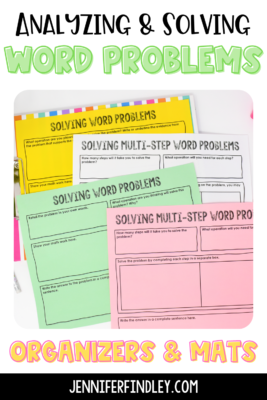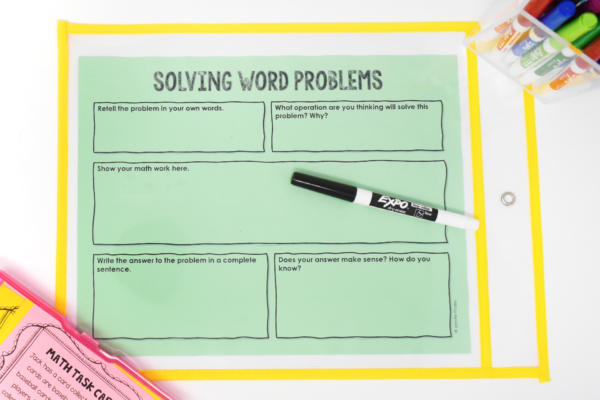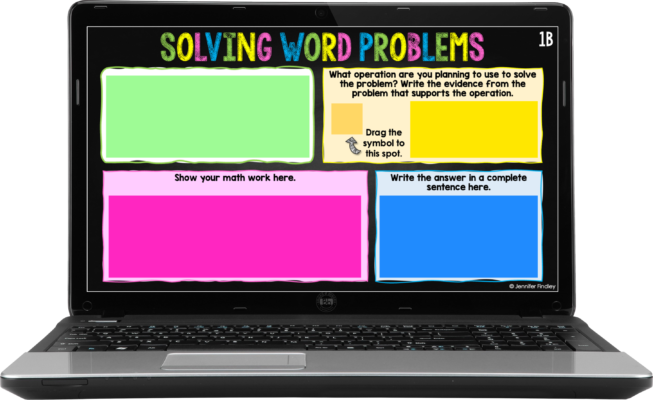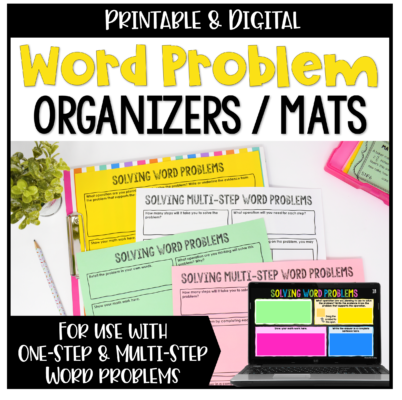Word problems used to be the bane of my existence as a new teacher. Thankfully, I learned new strategies and resources to help me implement and teach word problem strategies all year. To be honest, teaching word problems all year was the ONE thing that I did that had the greatest impact (if you are interested in more information about word problems and how I teach them, see the links at the bottom of this article). On this post, I will share one of those word problem strategies that involves helping students think through and analyze word problems using graphic organizers or word problem mats.
Teaching Word Problem Strategies with Word Problem Organizers
These word problem graphic organizers/mats help walk students through the thinking and analyzing process that is automatic for us. Through this analysis, the students have a better chance of comprehending the word problem, choosing the correct operation to solve it, and determining if their answers make sense.
In the same manner that we teach students to comprehend texts, we should also teach them how to breakdown and analyze a word problem. Using graphic organizers/mats helps break the process down into manageable steps for the students.
The free download (available a few sections down) has several different versions to allow you to choose which works best for your students and their needs. Having the different versions will also allow you to differentiate the organizers.
My go to version to begin with has the students following these steps:
- What operation are you planning to use? Write or underline the evidence from the problem that supports that operation.
- Solve the problem and show your math work.
- Write the answer in a complete sentence.
And here is an example from one of the more advanced organizers with more steps:
- Retell the problem in your own words.
- What operation are you thinking will solve this problem? Why?
- Solve the problem and show your math work.
- Write the answer to the problem in a complete sentence.
- Prove your answer is correct.
Using the Word Problem Organizers
You have a ton of variety in how you choose to use these organizers, however I definitely recommend following this sequence:
- Introduce the organizer/mat by going over the steps and how they help the student comprehend the word problem and/or organize their work. Understanding the purpose behind the organizer is huge with students because you don’t want them to view it as busy work.
- Model how to complete the organizer/mat whole group with at least one word problem (and more if the students need it and depending on the complexity of the organizer you choose).
- Allow the students to work in pairs or triads to complete the organizer as a form of guided practice before they are required to do so independently.
The graphic organizers/mats can also be used as a guide for students when discussing the word problem with partners. They don’t always have to fill in each part of it, but instead they can discuss some of the parts. This will give the same benefits in less time.
Also, placing the word problem organizers/mats in page protectors and letting the students use expo markers instantly makes it more engaging.
Here are some ways you can use these word problem mats to help your students practice analyzing word problems:
- Math centers
- Small group teaching
- Independent work
- Homework – send home a page protector and expo marker and let the students use the mats at home or they can use the mats as a guide as they work through word problems. These organizers will also help parents support students if they struggle with a word problem.
About the Digital Word Problem Organizers
There are digital versions of each of the word problem organizers included in the download below. The digital access link can be found on page 6. Each slide has text boxes for students to type into and interactive ways to complete some of the tasks.
The digital organizers are available in two versions, one with a designated spot to write a word problem and one without the space.
Should the students use the mat with every word problem they solve?
They certainly can (especially if you use dry erase markers and/or have them discuss some of the parts instead of recording it all) but they don’t have to. Using the organizers will help them work through complex problems but will take more time. When I use these in math centers, I only require one word problem to be worked on fully on the more advanced organizers. However this depends on the mat you choose. Some of them are more simple and don’t require any extra work- the mat simply organizes the work they would already do.
Download the Word Problem Strategies Mats
Click here or on the image to download the Word Problem Mats. Remember there are several versions so you can choose the ones that work best for your grade level and your students’ needs.
Need More Word Problem Strategies and Resources?
Check out these helpful resources, blog posts, and freebies for even more help teaching word problems.
Teaching Word Problems without Key Words (And What to Teach Instead)
Word Problem of the Day: FREE Starter Packs
8 Ways to Help Students Be Successful with Word Problems
Show the LOVE with Word Problems: Helping Students Answer Word Problems Effectively
Teaching Students How To Justify Answers in Math
Close Reading in Math Strategies and Freebies
10 Ways to Get Students Writing in Math
Solving Multi-Part Word Problems
4th Grade Word Problem of the Day TpT Resource
5th Grade Word Problem of the Day TpT Resource
The task card word problems shown in the images are part of my task card collections for 3rd-5th grade math. Click on the links below if you wish to see these resources in your grade level.
3rd Grade Common Core Math Task Card Collection
4th Grade Common Core Math Task Card Collection
5th Grade Common Core Math Task Card Collection
Is the category for this document correct?
Thank you for your participation!

No more boring flashcards learning!
Learn languages, math, history, economics, chemistry and more with free Studylib Extension!
- Distribute all flashcards reviewing into small sessions
- Get inspired with a daily photo
- Import sets from Anki, Quizlet, etc
- Add Active Recall to your learning and get higher grades!
Add to Chrome
It’s free
Princeton’s WordNetRate this definition:3.3 / 4 votes
-
problem, jobnoun
a state of difficulty that needs to be resolved
«she and her husband are having problems»; «it is always a job to contact him»; «urban problems such as traffic congestion and smog»
-
problemnoun
a question raised for consideration or solution
«our homework consisted of ten problems to solve»
-
trouble, problemnoun
a source of difficulty
«one trouble after another delayed the job»; «what’s the problem?»
WiktionaryRate this definition:3.3 / 3 votes
-
problemnoun
A difficulty that has to be resolved or dealt with.
-
problemnoun
A question to be answered, schoolwork exercise.
-
problemnoun
A puzzling circumstance.
Samuel Johnson’s DictionaryRate this definition:0.0 / 0 votes
-
PROBLEMnoun
A question proposed.
Etymology: probleme, Fr. πϱόβλημα.
The problem is, whether a man constantly and strongly believing, that such a thing shall be, it doth help any thing to the effecting of the thing.
Francis Bacon, Nat. Hist.Although in general one understood colours, yet were it not an easy problem to resolve, why grass is green?
Brown.This problem let philosophers resolve,
What makes the globe from West to East revolve.
Richard Blackmore.
WikipediaRate this definition:0.0 / 0 votes
-
Problem
Problem solving is the process of achieving a goal by overcoming obstacles, a frequent part of most activities. Problems in need of solutions range from simple personal tasks (e.g. how to turn on an appliance) to complex issues in business and technical fields. The former is an example of simple problem solving (SPS) addressing one issue, whereas the latter is complex problem solving (CPS) with multiple interrelated obstacles. Another classification is into well-defined problems with specific obstacles and goals, and ill-defined problems in which the current situation is troublesome but it is not clear what kind of resolution to aim for. Similarly, one may distinguish formal or fact-based problems requiring psychometric intelligence, versus socio-emotional problems which depend on the changeable emotions of individuals or groups, such as tactful behavior, fashion, or gift choices.Solutions require sufficient resources and knowledge to attain the goal. Professionals such as lawyers, doctors, and consultants are largely problem solvers for issues which require technical skills and knowledge beyond general competence. Many businesses have found profitable markets by recognizing a problem and creating a solution: the more widespread and inconvenient the problem, the greater the opportunity to develop a scalable solution.
There are many specialized problem-solving techniques and methods in fields such as engineering, business, medicine, mathematics, computer science, philosophy, and social organization. The mental techniques to identify, analyze, and solve problems are studied in psychology and cognitive sciences. Additionally, the mental obstacles preventing people from finding solutions is a widely researched topic: problem solving impediments include confirmation bias, mental set, and functional fixedness.
Webster DictionaryRate this definition:3.8 / 4 votes
-
Problemnoun
a question proposed for solution; a matter stated for examination or proof; hence, a matter difficult of solution or settlement; a doubtful case; a question involving doubt
-
Problemnoun
anything which is required to be done; as, in geometry, to bisect a line, to draw a perpendicular; or, in algebra, to find an unknown quantity
-
Etymology: [F. problme, L. problema, fr. Gr. anything thrown forward, a question proposed for solution, fr. to throw or lay before; before, forward + to throw. Cf. Parable. ]
FreebaseRate this definition:3.7 / 6 votes
-
Problem
A problem is the relation between human will and reality. When will and reality do not coincide, the resolution of this gap between reality and will is the solution of the problem. A problem implies a desired outcome coupled with an apparent deficiency, doubt or inconsistency that prevents the outcome from taking place.
Chambers 20th Century DictionaryRate this definition:3.0 / 1 vote
-
Problem
prob′lem, n. a matter difficult of settlement or solution: (geom.) a proposition in which something is required to be done.—adjs. Problemat′ic, -al, of the nature of a problem: questionable: doubtful.—adv. Problemat′ically.—v.i. Prob′lematise. [Fr.,—L.,—Gr. problēma—pro, before, ballein, to throw.]
Suggested ResourcesRate this definition:4.0 / 1 vote
-
problem
Quotes by problem — Explore a large variety of famous quotes made by problem on the Quotes.net website.
-
problem
Song lyrics by problem — Explore a large variety of song lyrics performed by problem on the Lyrics.com website.
Matched Categories
-
- Difficulty
- Question
British National Corpus
-
Spoken Corpus Frequency
Rank popularity for the word ‘problem’ in Spoken Corpus Frequency: #310
-
Written Corpus Frequency
Rank popularity for the word ‘problem’ in Written Corpus Frequency: #298
-
Nouns Frequency
Rank popularity for the word ‘problem’ in Nouns Frequency: #23
How to pronounce problem?
How to say problem in sign language?
Numerology
-
Chaldean Numerology
The numerical value of problem in Chaldean Numerology is: 4
-
Pythagorean Numerology
The numerical value of problem in Pythagorean Numerology is: 9
Examples of problem in a Sentence
-
Elon Musk:
Falcon 9 experienced a problem shortly before first stage shutdown. Will provide more info as soon as we review the data.
-
Lawrence Rosen:
If you bill Donald Trump fairly and you’re transparent and you get him results, you’re not going to have a problem.
-
Choo Chiang:
As Tiger was about to win the tournament, one of the Thai players said, Hey, its no problem, its a win for Thailand as well, and this was a professional on the Asian Tour.
-
Dimitris Kiosses:
The findings of the study are encouraging that problem-solving therapy may be beneficial as add on to outpatient rehabilitation, nevertheless, additional research is needed to better understand the discrepancies of the results.
-
Yi Liu:
NASA and Japan are sharing the best sensors, but not China, this is a problem. We need to work together to make this work.
Popularity rank by frequency of use
Translations for problem
From our Multilingual Translation Dictionary
- problemaAragonese
- مسألة, مشكلةArabic
- мәсьәләBashkir
- প্রব্লেমBengali
- poelladenn, kudennBreton
- problemaCatalan, Valencian
- problémCzech
- problemWelsh
- problemDanish
- Problem, ÜbungGerman
- πρόβλημαGreek
- problemoEsperanto
- dificultad, lío, bronca, embrollo, problema, ejercicioSpanish
- mure, harjutus, probleem, kitsikus, küsimus, mõistatus, takistusEstonian
- arazo, buruketa, buruhausteBasque
- مشکل, مسئلهPersian
- harjoitus, vaikeus, probleemi, ongelma, harjoitustehtäväFinnish
- problèmeFrench
- duilgheadas, staingScottish Gaelic
- problemaGalician
- בעיהHebrew
- समस्याHindi
- feladat, baj, gond, problémaHungarian
- հարց, խնդիրArmenian
- problemaInterlingua
- problemaItalian
- 問題Japanese
- პრობლემა, ამოცანაGeorgian
- 문제Korean
- problemaLithuanian
- problēma, uzdevumsLatvian
- задача, проблемMacedonian
- хүндрэлMongolian
- kesulitan, masalah, kemusykilanMalay
- problemNorwegian
- probleem, oefeningDutch
- problemNorwegian Nynorsk
- oppgave, utfordringNorwegian
- problèmaOccitan
- kłopot, zadanie, problemPolish
- problema, exercícioPortuguese
- problemăRomanian
- проблема, задача, заданиеRussian
- समस्याSanskrit
- проблем, zadatak, jednadžba, problemSerbo-Croatian
- çështje, problemAlbanian
- problemSwedish
- tatizo, masaibuSwahili
- เรื่อง, โจทย์, ปัญหาThai
- problemaTagalog
- sorunTurkish
- vấn đềVietnamese
- פּראָבלעםYiddish
Get even more translations for problem »
Translation
Find a translation for the problem definition in other languages:
Select another language:
- — Select —
- 简体中文 (Chinese — Simplified)
- 繁體中文 (Chinese — Traditional)
- Español (Spanish)
- Esperanto (Esperanto)
- 日本語 (Japanese)
- Português (Portuguese)
- Deutsch (German)
- العربية (Arabic)
- Français (French)
- Русский (Russian)
- ಕನ್ನಡ (Kannada)
- 한국어 (Korean)
- עברית (Hebrew)
- Gaeilge (Irish)
- Українська (Ukrainian)
- اردو (Urdu)
- Magyar (Hungarian)
- मानक हिन्दी (Hindi)
- Indonesia (Indonesian)
- Italiano (Italian)
- தமிழ் (Tamil)
- Türkçe (Turkish)
- తెలుగు (Telugu)
- ภาษาไทย (Thai)
- Tiếng Việt (Vietnamese)
- Čeština (Czech)
- Polski (Polish)
- Bahasa Indonesia (Indonesian)
- Românește (Romanian)
- Nederlands (Dutch)
- Ελληνικά (Greek)
- Latinum (Latin)
- Svenska (Swedish)
- Dansk (Danish)
- Suomi (Finnish)
- فارسی (Persian)
- ייִדיש (Yiddish)
- հայերեն (Armenian)
- Norsk (Norwegian)
- English (English)
Word of the Day
Would you like us to send you a FREE new word definition delivered to your inbox daily?
Citation
Use the citation below to add this definition to your bibliography:
Are we missing a good definition for problem? Don’t keep it to yourself…
Do your students struggle to solve world problems? I am a big proponent of helping students understand the context of the word problem and solve the problem while understanding what is going on in the problem. Below is a word problem routine that I ran across a couple of years ago and was able to integrate in how I teach students to solve word problems.

This structured routine easily integrates with my Addition & Subtraction Word Problems Grouped by Problem Type and just adds another layer to the process.
Components of this Word Problem Routine
This word problem routine makes explicit several features of word problems, including the numbers, the question, the equation, a model, and the “answer”.
Can you can see the three numbers above, 1, 2, and 3. Those delineate the problem, the work and the answer. Within the work section, students create a four-square to outline the numbers, question, equation, and model.
How do I use this word problem routine in the classroom?
I introduced this routine part way through the year, meaning we had already done quite a bit of work with analyzing word problems with blank spaces for the numbers. My students knew how to read a word problem and find the action, but we were starting to use larger numbers and some of them needed a more concrete structured system.
Set up the Work Area
To begin, I have students glue the problem in their journals and draw a four square and a line across the bottom. We number sections, 1, 2, 3 and make explicit that the sections are the problem, the work and the answer.
Read and Analyze the Problem
We read the problem and analyze the action in the problem to create the equation. In this problem, the character gave something to someone. Gave is a verb that denotes subtraction.
At this point, we write down the question and the equation, leaving blank spaces for the numbers. We determine the unknown in the problem.
Although not written on the above copy, we do discuss the start, change and result to determine which of those is unknown. This is not a new concept for students as we started using that vocabulary on day one of solving word problems.
Give Students the Numbers
I give students the numbers for the word problem, adjusting numbers for specific students who need a little easier work or who need more of a challenge. Students write the numbers in the problem, in the first box, in the equation, and then use the numbers to determine an appropriate model.
Most often, I will model a problem using a number line, but students are free to choose their own models as long as they can explain their thinking using the model.
Solve the Problem
Students are then given time to solve the problem and work through the model. I circulate to help students as needed and encourage a few to try a different strategy of the work is too easy or to challenging.
Write about the Process
This structured word problem routine gives students the ability to write about the problem and analyze their process. By breaking down the “work” area into numbers, question, equation and model, students are able to see how the process moves through stages rather than them just “knowing” the answer. Students are able to use the routine to write about each stage of the process.
Variations
The work area is not set in stone. The boxes can be changed around to fit your classroom and the way you teach students to solve word problems. One area that I change is the question box. I sometimes make it an “action” box where students write in the word or phrase that tells them the operation. In this instance, it would be the word gave.
Do you want a free sample of the word problems I use in my classroom? Click here or the image below. FREE Sample of Word Problems by Problem Type
I love scaffolding learning for students and helping them to figure out how they’re learning something. Below are some products and blog posts about solving word problems.
Word Problems Teaching Resources for Your Classroom
Are you teaching word problems and do you need more resources to meet the needs of all of your learners? Check out these word problem resources for your classroom.
-
Multiplication Division Word Problems Number Puzzles – OA3
$3.75
-
Two-Step Word Problems Number Puzzles – OA8
$3.75
-
Addition and Subtraction Word Problems by Problem Type
$24.75
-
Multiplication and Division Word Problems
$19.75
-
Word Problem by Problem Type BUNDLE
Product on sale
$38.80
-
Second Grade Math BUNDLE
$200.00
More Ideas for Teaching Word Problems
Are you looking for more ideas for teaching word problems to your elementary students? Check out these blog posts.
2 Responses
-
Hi Jessica,
Question: I have read your other blogs about the Start, Change, Result word problem method……do you have your students use both of these methods? Do you prefer one over the other?-
I prefer the more in-depth teaching by problem types (start, change, result for join and separate problems). However, that doesn’t mean you can’t use this routine with problem types. In the “read and analyze” section, you can list the start, change, and result, identifying what is unknown. This is a routine for solving word problems, more of a process or a set of steps. The identification of the components of the word problem by problem type (for join and separate problems, that’s start, change and result), is a piece of the process or a strategy in the “analyze” step. Hope all that makes sense 🙂 . They’re not mutually exclusive, but can be used together. I do start with the word problem analysis before introducing this routine, though. I want students to be able to read a word problem and identify its components. Either way, the goal is to eventually remove scaffolds so that students internalize any and all strategies and processes.
-
Leave a Reply
Answers
Other questions about: Math
-
Math 2 28.10.2019 19:29
-
Math 1 28.10.2019 21:29
-
Math 1 28.10.2019 22:29
-
Math 1 28.10.2019 22:29
-
Math 2 30.10.2019 22:28
-
Math 3 14.11.2019 15:29
Connaissez-vous la bonne réponse?
Analyze the word problem by answering the question below…
Popular questions
-
Art
1
28.10.2019 16:28 -
Health
2
28.10.2019 19:28 -
Math
1
28.10.2019 19:29













